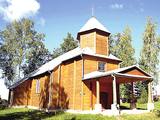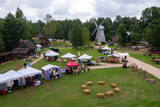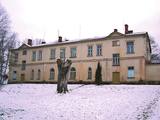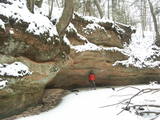| Nr | Name | Beschreibung |
|---|---|---|
|
In „Silkalni” können Besucher die verschiedenen auf Wiesen, Feldern und im Garten, Wald und Sumpf, Hof oder Pflanzbeet wachsenden Heilkräuter, deren Nutzung zur Gesundheitsunterstützung kennenlernen. Während der Führung zeigt die Wirtin die Heilkräuter, die Geheimnisse der Zucht, Sammlung, Trocknung und Teemischung sowie die Zubereitung von Sirupen. Die Besucher können verschiedene Heilkräutertees kosten und kaufen. Auf besonderen Wunsch kann der Wirt Interessenten über Naturenergien – Erdstrahlen und die Kraft der Steine erzählen und eine Führung machen. |
||
|
Hier kann man die Geschichte und das Kulturerbe der Liven von Vidzeme kennenlernen, indem man die Sammlung des Museums besichtigt und die Gerichte und Getränke probiert, die früher dieser Region charakteristisch waren: Graupengrütze und das nach alten Rezepten gebraute, starke alkoholische Getränk Škaļika. Gruppen von Interessenten können hier in einem ländlichen Ofen Roggenbrot backen. Lettische Küche: Gerstengrütze mit gebratenen Fleischstücken und Zwiebeln und mit Marmelade oder Soße aus Moosbeeren oder Preiselbeeren, Kräutertee mit einem Moosbeerensirup, alkoholisches Getränk Škaļiks. |
||
|
Saimniecībā "Jauncaunes", Ogres novadā, grupām, kā arī individuāliem apmeklētājiem tiek piedāvāta atpūta brīvā dabā, iepazīstot un izmēģinot metamos ieročus, šaušanu ar dažāda veida lokiem, arbaletiem un pneimatiku. |
||
|
The tower is at the western end of the Seda swamp, accessed from the side of Jērcēni. Transport is limited here. The tower is in the area of the swamp where peat moss is extracted. It offers a broad view of the ponds of Seda and a boat rental facility that is nearby. It is an appropriate location for bird-watching during the season of migration. There is another bird-watching platform near the town of Seda. This is part of the ZBR. |
||
|
Das Rainis – Museum „Jasmuiža“ (Raiņa memoriālais muzejs „Jasmuiža”) Von 1883 – 1891 lebte Rainis‘ Vater Krišjānis Pliekšāns in dem Herrenhaus, das ehemals im Besitz der Familie Šadurski gewesen war. Der junge Dichter Rainis verbrachte hier seine Jugendjahre, wie es sich in dem Werk „Im Land meiner jungen Jahre“ (“Manu Jaunu dienu zemē”) wiederspiegelt. In Jasmuižā entstand auch die Übersetzung von Puschkins Drama „Boris Godunow“. Um das Werk des Dichters zu würdigen, wurde 1964 im Verwalterhaus des Gutshofes die Ausstellung „Rainis‘ Gymnasial- und Studienjahre“ geschaffen. Im renovierten Kuhstall des Hofes kann man Töpferarbeiten aus Latgale sehen. |
||
|
St. Anthony Roman Catholic Church of Pilcene (Piļcine) is the oldest wooden church in Latgale, built
in 1670. It is prominent because of its half columns, hexagonal tower, semicircular windows, and a dome
with a cross and antique interior.
|
||
|
Before a great storm in 2005, this was one of the tallest and most noble lime trees in Latvia. Now only one branch is still alive.
|
||
|
Atrodas Īvandes dienviddaļā, Vankas upītes krastos. Ūdensdzirnavas celtas 1842. gadā (par to liecina arī sienā iemūrēts dzirnakmens) un darbojas joprojām. To iekārtas ir saglabājušās no 1930. gada. Divstāvu ēka apskatāma no ārpuses, bet iepriekš piesakoties, - arī no iekšpuses. |
||
|
Die Windmühle ist von 1867 bis 1869 im holländischen Stil gebaut worden. Der Namen erwarb die Windmühle nach dem Familienname des ersten Besitzers – Riba. Die Windmühle ist eins der besser erhaltenen Architekturdenkmäler dieser Typs in Lettland. Auf der Windmühle ist die dauerhafte Exposition “Der Weg vom Getreide” errichtet, die über landwirtschaftliche Entwicklung in Semgallen, die Traditionen der Getreidezucht und des Brotbackens erzählt. Es werden Exkursionen mit Guidebegleitung angeboten. Die Windmühle gehört zum Erholungskomplex (Hotel, Restaurant, Mühle) „Rožmalas”. |
||
|
"Anima Candles" sveces ir roku darbs. Svecēm pieejami vairāki dizaini, kas variē gan krāsās, gan izgatavošanas metodē. Krāsu un smaržu klāsts ir plaši pieejams. Tās izgatavotas no pārtikas rūpniecībā izmantojamā parafīna vai ekoloģiskās sojas. Sveču ražotnē tiek piedāvātas sveču liešanas meistarklases.
|
||
|
Эта поездка на автомобиле предусмотрена для всей семьи и особенно понравится детям. Вы сможете понаблюдать за работой гончара, а также мастер с удовольствием посвятит Вас в секреты своего мастерства. Побывать в гостях у барона Мюнхаузена, знаменитого своими многочисленными приключениями. Погулять по улочкам Цесиса и отправиться дальше в крестьянское хозяйство, где разводят кроликов. Малышам особенно понравится играть с крольчатами в открытых вольерах. Хозяева оленьего питомника расскажут о жизни диких животных – оленях, кабанах. Вы сами сможете наблюдать за животными со смотровых вышек. В хозяйстве экзотических животных увидите страусов, муфлонов, пони и карликовых свиней. По пути домой рекомендуем насладиться красотами Сигулды. |
||
|
Am rechten Ufer des Flusses Iecava erhebt sich das erneuerte Gebäude der Mühle. Auf dem Hof und in seinen Wirtschaftshäusern sind der lettischen Feldlandschaft charakteristische Werkzeuge, Maschinen, Triebwerke und Haushaltsgegenstände ausgestellt. Hier kann man auch eine Schmiede besichtigen. Jedes Jahr werden hier thematische Veranstaltungen organisiert: Frühlingsarbeiten auf einem Hof (am zweiten Samstag im Mai) und Erntefest (am ersten Samstag im September). |
||
|
"Dobele Agra S.I.A." ir moderns, nākotnes perspektīvā domājošs lauksaimniecības uzņēmums Latvijā. "Dobele Agra S.I.A.", kas atrodas netālu no Dobeles - Krimūnās, kā viens no lielākajiem aramzemes apstrādātājiem Latvijā pašlaik apstrādā apmēram 5 800 ha lauksaimniecības zemes Dobeles un Jelgavas rajonos. Uzņēmums specializējas graudaugu audzēšanā pārdošanai vietējos un starptautiskajos tirgos, tādējādi gadā tiek saražotas apmēram 20 00 - 25 000 tonnas graudaugu, no kuriem lielākā daļa ir kvieši mieži, rapsis un pākšaugi. Pārsvarā tiek audzētas ziemas šķirnes. |
||
|
Ap 100 gadus veca priežu audze, ko iesēja pagājušā gadsimta sākumā. Sēklu materiāls bija nācis no kādas Vācijas (Darmštatē) sēklu tirdzniecības firmas. Mūsu klimatiskajos apstākļos priežu stumbri izauga līki un kroplīgi. Savdabīgā audze labi redzama no šosejas malas.
|
||
|
Der Name von Subate ist zum ersten Mal im Jahr 1570 erwähnt worden, als der kurländische Herzog Kettler dem Grafen G. Plater-Sieberg den Platz des Marktes verkauft hat. Als im 17. Jh. die Familie Plater-Sieberg zum katholischen Glauben übergegangen ist, protestierten die evangelisch-lutherischen Einwohner von Subate und sind zum östlichen Ufer des Sees von Subate umgezogen, der das Eigentum der Familie von Osten-Sacken war, der auch das Landgut von Prode (heute nur Ruinen) gehörte. Im Jahr 1685 hat die Familie von Osten-Sacken den Überläufern eine evangelisch-lutherische Kirche gebaut, um die sich die Ortschaft Jaunsubate herausbildet hat. Beide Stadtteile wurden im Jahr 1894 vereint. Während der Freiheitskämpfe im Jahr 1919 wurde Subate von Litauern befreit, danach folgte die Teilung der Stadt zwischen Lettland und Litauen (im Jahr 1921 wurde die Grenze auf der ehemaligen Linie festgelegt). Das historische Zentrum von Subate bildete sichvom 16. bis 19. Jh. heraus. In dem Zentrum kann man Gotteshäuser von vier verschiedenen Konfessionen und eine Bebauung aus kleinen Holzhäusern besichtigen, die sich am Rand von schmalen und sich windelnden Straßen befinden. Die Stadt liegt an den Ufern einer subglazialen Bettung, in der sich auch die Seen Lielais Subates ezers und Mazais Subates ezers befinden, darum bieten auch die Naturverhältnisse der Stadt einen für Lettland nicht charakteristischen Blickwinkel. |
||
|
Ein ehemaliges Fischerdorf am Ufer des Kurischen Haffs. Aufgrund der Wanderdünen hat seinen Standort mehrmals seit dem Anfang des 19.Jh. geändert. Holzbebauung mit einheitlichem Stil und Traditionen. |
||
|
Bikovas Manor. The name of this manor is listed in the chronicle since the 17th century. You should see the manor house
and the park where you can find a stone chapel that was built in 1820, servant’s house, several household buildings
and stablings. After the fire of 1905, the building was reconstructed and the second floor was built. Since
1937, the manor is serving as Gaigalava Secondary school. According to the legend, there are secret passages that
lead to the church and the cemetery. The building is the architectural monument of local importance.
|
||
|
Angeboten werden erstklassiges „Street Food" und moderne lettische Küche, Fleisch-, Fisch- und vegetarische Gerichte, eine große Auswahl an Getränken und eine moderne Inneneinrichtung. |
||
|
Das Kaļķupe – Flusstal wird geschützt, da der Fluss Pilsupe durch die Blauen Berge von Šlītere in den Süden nach Vīdale und Kaļķi fließt. Das ausgeprägte Flusstal hat ein verzweigtes Netz von Schluchten, in denen der Devonische Sandstein teilweise unbedeckt ist. Der Puiškalns – Hügel, der einst Burgberg und eine heilige Stätte in der Vergangenheit war , ist einer der markantesten Plätze in diesem Gebiet. Er ist ein beliebtes touristisches Ziel in der Region Talsi. Hangwälder, verschiedene Arten von Wiesen und eine große Zahl an Pflanzenarten sind ebenfalls wertvoll für die örtliche Umgebung.
|
||
|
Находится на улице Лиела, д. 84, в Гробине (т.н. Докторат), где прошло детство писательницы З. Маурини. В Докторате гостили многие известные работники латышской культуры, что оказало большое влияние на будущую писательницу. В 1997 году в здании была создана комната памяти, где писательница жила с 1898 по 1921 год. Посетители могут осмотреть разные экспонаты и увидеть фильм, посвященный столетию З. Маурини. |
||

























